Brigg Fair is an English folk song best known as a choral arrangement by Delius’ friend, Percy Grainger. The set of variations by Delius written on Brigg Fair were published in 1907 and are considered to be one of his first mature works, marking the beginning of his most productive period. I will be using a piano reduction throughout this analysis for ease of reading, but the full orchestral score for Delius’ variations on Brigg Fair can be found here.
Following a sparse, serene introduction, the main theme is introduced around 2 minutes into the piece. The 16 bar melody itself which Delius uses for his variations is in the G dorian mode and is notated in 3/8 time.

In this analysis, I will only be looking at the first variation of the theme, though I intend on analysing the following three in the near future. Delius makes only very slight changes to the melody itself during the first four variations, the vast majority of the development being harmonic. Unlike a traditional set of variations, Delius doesn’t provide the listener with an unaltered version of the theme before embarking on variants of it. The first rendition of the theme is as follows:
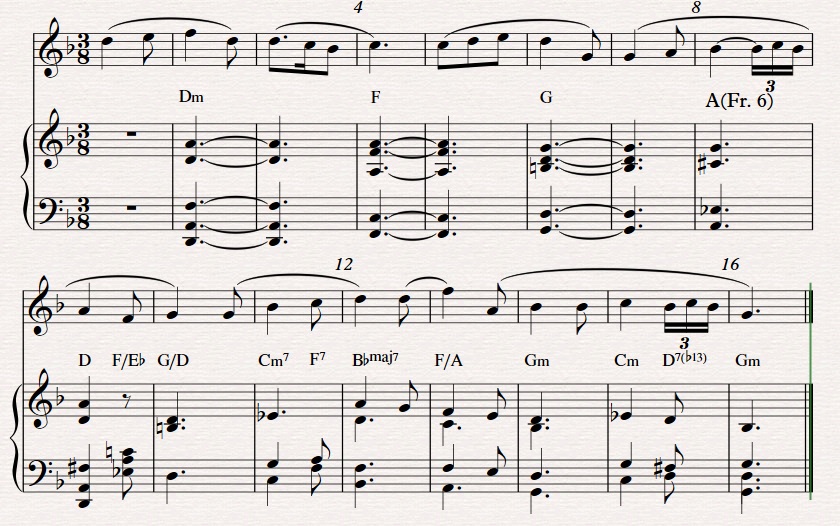
This passage can be clearly split into two halves; bars 1-7 are the only real reference to the original G dorian harmony of Brigg Fair, though even in this Delius includes a B natural as part of the G major chord in bar 6. In general though, these opening 7 bars are characterised by simple triadic harmony and a much slower harmonic rhythm than that which follows. This can perhaps be viewed as a very brief version of the original theme which is usually stated unaltered at the beginning of a set of variations.
The triadic approach Delius takes in this opening section is interrupted with a much more complex and dissonant chord of an A French augmented 6th in bar 8. The chord (along with all other types of augmented 6th chords) is generally considered to be an extended secondary dominant.
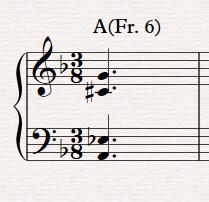
Put simply, in the key of C, D7 is the secondary dominant (or dominant of the dominant). The step to an augmented 6th chord occurs when A (the 5th of the D7 chord) is chromatically altered to an Ab. This creates a chromatic movement from Ab to G, as the chord following an augmented 6th is almost always a V or I/V chord. The augmented 6th in the name of the chord refers to the relationship between Ab and F#.

This chord can also suggest a whole tone sound and has occasionally been used in this way since around 1900. The chord itself though has been in use since long before Delius’ time as can be seen in the following examples:
Beethoven Piano Sonata in F minor, Op. 2, no. 1, first movement (bars 61 – 63)

Chopin Mazurka no. 19, Op. 30, no. 2, (bars 17 – 28)
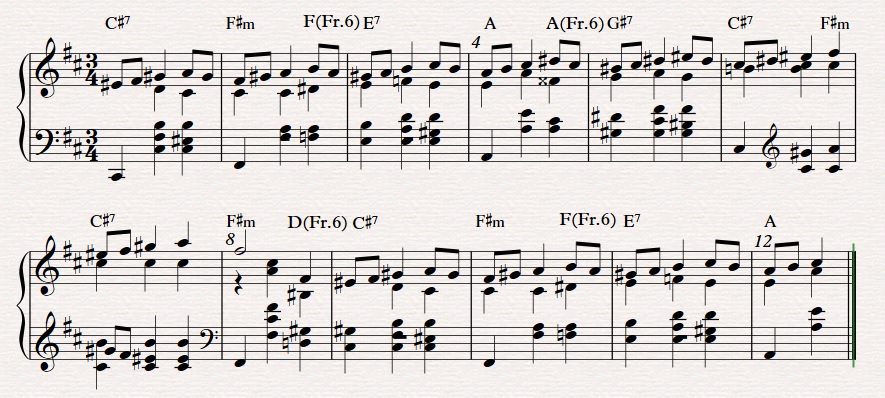
It has even been suggested by Walter Piston in his book ‘Harmony’ (1941) that the chord at bar 2 of the following example from Wagner’s famous opening to Tristan and Isolde is a French augmented sixth. The G# acting as an appoggiatura to the A natural which follows:

Delius’ use of this chord is in stark contrast to all of these examples however as he treats the chord more as a V chord in itself, rather than a VI chord which tends to resolve to V or I/V. In this case the A French augmented 6th chord resolves directly to a D major chord, creating a V – I relationship.

This could suggest that it isn’t a French augmented 6th at all, but rather an A7 with a flattened 5th, though the fact that he invariably spells this chord with augmented 6th interval would suggest otherwise. Either way, this chord seems to be a favourite of Delius’ and appears countless times throughout the Brigg Fair variations as well as in his other works.
Following this, a quick passing chord is used in bar 9 (beat 3) resolving to G major.
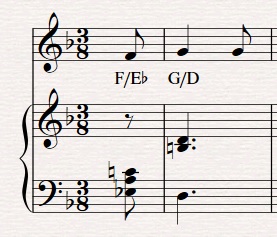
As with a lot of Delius’ music, this chord is probably better seen as a chromatic passing chord reliant on voice leading than as a vertical tonal element. The Eb to D in the bass and the F major to G major chords on top create a contrary motion relationship resulting in smooth, though non-diatonic voice leading.
With the exception of the brief F/Eb passing chord just mentioned, the harmony here makes use of the cycle of 5ths. From bars 8 to 12, every chord moves up a fourth from the previous chord, so what Delius is doing here is in some ways very conventional, modulating temporarily to D major, G major, and finally chord II in Bb major, all via V – I relationships.
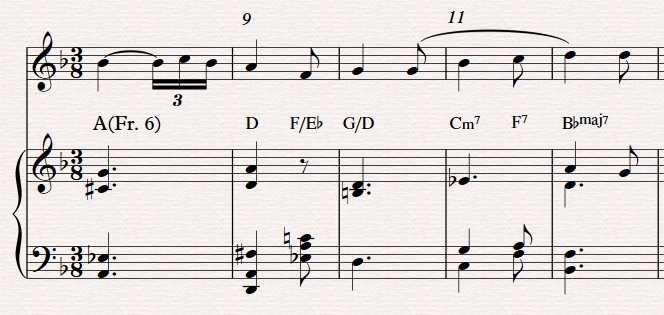
From here the music becomes more diatonic, whilst the harmonic rhythm remains at one or two chords per bar. The harmony continues to move in fourths, though now staying within Bb major (in bars 11-12) in the form of a ii7 – V7 – I progression. A simple iv – V7 – I progression in G minor then ends the passage (in bars 15-16), leaving us in the original G minor tonality of the theme.

This first variation is typical of Delius’ complex harmonic style; quick harmonic rhythm, chromatic passing chords, use of French sixth chords, and a general favouring of voice leading over harmonic progression all combine to create his distinctive sound. These devices (as well as the use of chromatic and quartal harmony) will be used through the next 3 variations which I will aim to analyse soon.
Any comments, suggestions or corrections please get in touch.
2 thoughts on “Brigg Fair – First Variation”